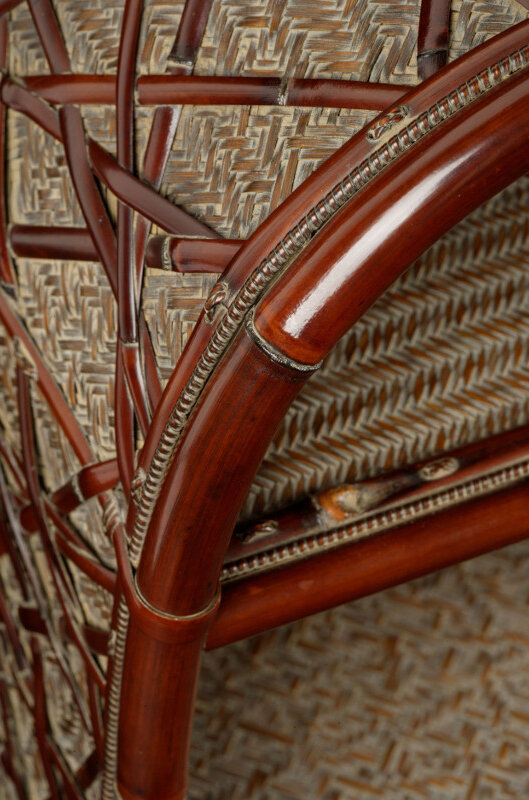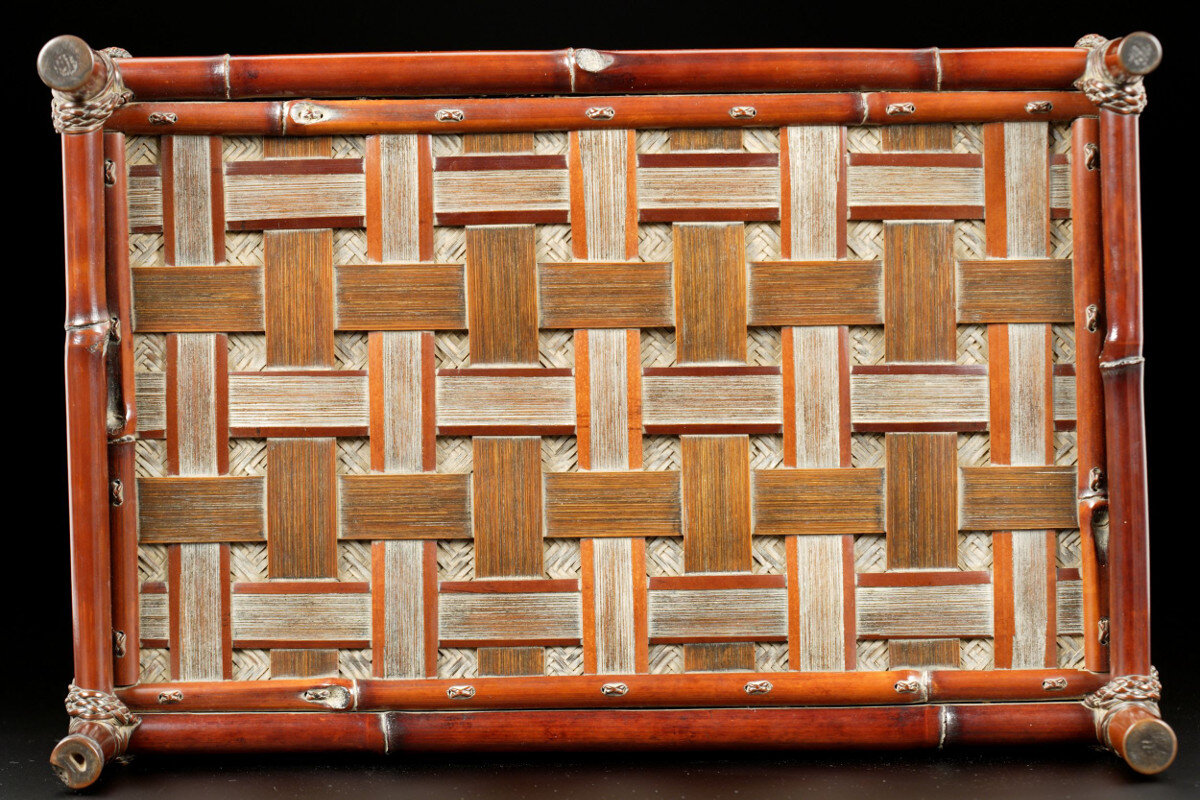BASKETRY
IIZUKA ROKANSAI, SMOKED BAMBOO KIKYOKU SENCHA TEA CABINET
Kikyoku or cabinet for sencha tea ceremony implements, in a rectangular form set onto four legs, the sides arching across the upper shelf, and the interior space enclosed with a drop fit panel. Woven of richly toned, red-brown smoked and split as well as branch bamboo, stripped and stained split bamboo, and stained rattan. Signed on one of the back corner sections with an incised signature by the artist: Rokansai Saku or Made by Rokansai (Iizuka Rokansai, the go or art name of Iizuka Yanosuke, 1890 – 1958). Late Taisho – early Showa era, circa 1922 – 1932.
With the tomobako or original box, inscribed on the exterior of the lid: Kikyoku or Sencha Tea Ceremony Cabinet; and on the reverse of the lid signed: Rokansai Saku or Made by Rokansai, and sealed twice: Iizuka no In or Seal of Iizuka, and: Sekichiku or Stone-bamboo. Note: the signature and seal are consistent with those illustrated in Iizuka Rokansai: Master of Modern Bamboo Crafts, pages 118 – 119, top register, for 1925 and 1931 (for which the handwriting appears to be almost an exact match).
Rokansai conceived of this cabinet for sencha implements like a jewel box, framed in smoked bamboo of glowing red-brown color and similar abstract overlays that contrast with the precise formality of ornamental plaiting and knotting on the side panels. The sides, arching top, back and base are woven in flower twill plaiting (hana ajiro ami) from finely split bamboo from which the satin-skin has been cut away, and the surface stained. Then Rokansai applied an ash toned pigment to the surface, wiping this away from the raised areas in the plaiting to create a contrasting texture that highlights the weaving. The drop fit panel employs the same techniques on the interior, but the flower twill plaiting creates a repeating diamond pattern framed by twill plaiting (ajiro ami). On the top shelf this same motif repeats, but the two central medallions are offset one from another. Overlays of gleaming smoked bamboo frame each of the woven planes making up the cabinet. Attaching them are repeating ornamental rice-character stitch knots (kome-no-ji-dome), each lacquered a jewel-like red-brown. Long lines of lacquered rattan in simple wrapping (bo-maki) create a beaded effect separating the tubular framing bamboo and the framing overlays. On the front of the drop-fit panel, overlays of smoked bamboo cut into stays of widely differing widths form an irregular but rectangular geometric pattern, with a loop handle of lacquered rattan executed in insect stitch (mushi-kagari). On the arching sides and on the lower back panel, criss-crossing overlays ornament the surface with gleaming abstraction, their scattered and closely trimmed nodes echoing the texture of the contrasting plaiting below. Complex ornamental cross knots (juji-musubi) anchor the body of the cabinet to each of the four legs. On the reverse of the upper shelf and on the base of the cabinet, a square plaiting overlays the fine ornamental twill weaving. For this treatment broad slats of smoked bamboo in differing widths were scored lengthwise with a knife to remove part of the satin surface. On these a mixture of stain and ash finishes the roughened areas. The remaining slats were completely stripped of skin and then stained brown for higher contrast.
For a comparison with two sumikago or charcoal baskets for tea ceremony, c.f. Iizuka Rokansai: Master of Modern Bamboo Crafts, page 42, numbers 40 and 41. Those baskets share with this cabinet the use of overlays and lines of formal simple wrapping, though the scale and complexity of both cannot touch that of this kikyoku.
While his brother, Iizuka Hosai II, made a number of these cabinets (for two of which c.f. Masters of Bamboo Art: Iizuka Hosai, Rokansai and Shokansai, number 19 and 23), only one other similar piece by Rokansai is known from an old black and white photograph (in the same catalogue, c.f. the 1922 flower basket in the form of a prayer cabinet, exhibited at the Heiwa Kinen Tokyo Hakurankai Ginpai (Peace Memorial Tokyo Exposition) where it won the silver medal and was purchased by the Imperial Household Agency).
This kikyoku is among Rokansai’s most brilliant work. At once formal and playfully abstract in ornamentation, it displays a complexity of textures, color, and weaving idiom. Since he never seemed to return to this genre of object, we believe that it must have been a high-level, private commission. It should be no surprise that it dates from the years when Rokansai’s reputation was first propelled into the stratosphere of the Japanese art world. This period during his thirties and forties was one of great creativity for him, and reflects his maturation into an artist of great genius.
Iizuka Rokansai, Smoked Bamboo Kikyoku Sencha Tea Cabinet
Artist Name: Iizuka Rokansai
Period: Taisho Showa
Mediums: Bamboo
Form: Basket
Origin Country: Japan
13 1/8” high x 13 1/8” wide x 8 5/8” deep
This piece is no longer available.







